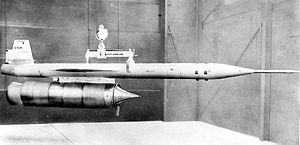Lockheed X-7
| X-7 | |
|---|---|

| |
| Role | Experimental aircraft |
| Manufacturer | Lockheed Corporation |
| First flight | 1951 |
| Retired | 1960 |
| Primary user | United States Air Force |
| Developed into | AQM-60 Kingfisher |
The Lockheed X-7 (dubbed the "Flying Stove Pipe") was an unmanned test bed for ramjet engines and missile guidance technology. It was carried aloft by a B-29 or B-50 Superfortress carrier aircraft. The booster rocket ignited after launch and propelled the vehicle to a speed of 1,000 mph (1,625 km/h). The booster was then jettisoned, and the underslung ramjet took over from that point. The X-7 eventually returned to Earth, its descent slowed by parachute. A maximum speed of 2,881 mph (4640 km/h / Mach 4.31) was attained, setting a record for fastest air-breathing aircraft at the time. A total of 130 X-7 flights were conducted from April 1951 to July 1960.
The X-7 was also used to test HEF-2 and Hi Cal-3 Boron-based fuel, which has a superior heating value of 26,500 Btu/lb. compared to hydrocarbon fuel with 18,400 Btu/lb.[1]
Specifications (X-7A-1)
| This aircraft article is missing some (or all) of its specifications. If you have a source, you can help Wikipedia by adding them. |
General characteristics
- Crew: None
Performance
References
- ^ "A-11 General VI-1" (PDF). CIA. January 1968.
{{cite web}}: CS1 maint: year (link)
See also
Related development
Aircraft of comparable role, configuration, and era
